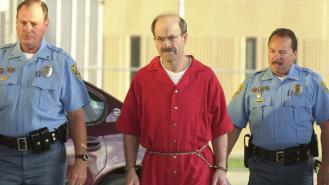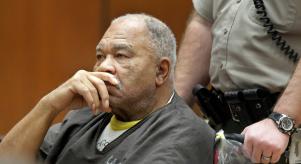
'Big Ed': Edmund Kemper, the 6ft 8in serial killer
Edmund Kemper was born in Burbank, California, on the 18th of December, 1948. The relationship between his parents, Clarnell and Edmund Sr., was extremely tumultuous and his childhood was marred by abuse.
To 'make Edmund into a man,' Clarnell ordered Edmund to live in the dark basement where he had recurring nightmares. He was kept ignorant and Clarnell ingrained into him that his body was dirty and that emotions and feelings were wrong. Affection was discouraged by Clarnell and Edmund had a complete lack of sex education. In fact, Clarnell had become so convinced that Edmund would molest his sisters that she placed a kitchen table over the trap door so that Edmund couldn’t sneak out of the basement.
Throughout his childhood, Edmund was plagued with violent fantasies. On one occasion, he buried the family’s cat alive and afterwards, he dug it back up, cut off its head and mounted it on a spike. On another occasion, he waited for hours with a rifle over a squirrel’s hole to blow its head off when it peeked out. Then when Edmund was 13-years-old, he killed the family’s second cat because he was jealous that the cat seemed to prefer his younger sister over him.
Young Edmund frequently cut off the heads of his sister’s dolls and enjoyed playing a macabre game which he had named ‘electric chair.’ He ordered his sister to tie him to a chair, pretend to flick a switch and he would then jerk around and pretend that he was being electrocuted. When Edmund had a crush on his teacher, his sister tried to encourage him to kiss her to which he replied: ‘If I kiss her, I’d have to kill her first.’
While Edmund’s behaviour raised red flags which could have predicted murderous tendencies, neither of his parents ever sought out help for him. Instead, they shipped him off to become somebody else’s burden. In 1963, 14-year-old Edmund Kemper was sent to live with his grandparents in North Fork, California, after stints with both of his divorced parents had failed.
In August of the following year, Edmund and his grandmother, Maude, got into a verbal argument while at the kitchen table. Edmund stormed off and retrieved his grandfather’s .22 rifle. He made his way outside the house and took up a vantage point at the porch window. He slowly lifted the rifle to the window sill, aimed towards his grandmother and fired.
The first bullet struck Maude in the back of the head. In quick succession, he fired two more shots which struck her in the back. He dropped the rifle and entered the kitchen, picked up a butcher knife and dragged Maude’s lifeless body into the bedroom where he proceeded to stab her three times. He later said: ‘I just wondered how it would feel to shoot grandma.’
The murder had unfolded while Edmund’s grandfather, Edmund Sr., was running errands in the town. After making sure that Maude was dead, Edmund went to the porch to await his grandfather’s return. According to Edmund, he knew that he needed to kill his grandfather so that he would not have to see what he had done. As Edmund Sr. approached the porch, he smiled at his grandson, thinking that he was there to greet him.
When he turned to enter the front door, Edmund aimed and shot him once in the back of the head, killing him instantly. Edmund then dragged his grandfather’s body into the garage and wasted no time before ringing the police to inform them what he had done. In regards to a motivation, Edmund said that he was mad at the world and didn’t want to return to live with his father or mother and didn’t want to stay with his grandparents.
Edmund was tried as a juvenile and was sent to Atascadero State Hospital where he impressed psychiatrists so much that they allowed him to administer tests to other inmates. Here, he honed his manipulation skills and learned from other inmates that if you want to commit a crime and get away with it, you leave no witnesses alive. When Edmund turned 21, he was paroled and released into the care of his mother in Santa Cruz, California. By the time Edmund left the psychiatric hospital, he was standing at 6 feet 9 inches tall and weighing 280 pounds. His appearance would earn him the moniker: ‘Big Ed.’
By all appearances, Edmund was a well-adjusted young man. He was always polite and respectful and enjoyed talking to the local police officers at the local bar, The Jury Room. He was conservative and he liked to ride a motorcycle and keep his hair short. He lived vicariously through the stories of the police officers; it was the closest thing he could get to becoming a police officer which had been his lifelong ambition. He had an IQ of 136, and had a sticker on his car from the University of California Santa Cruz where his mother worked. He was extremely approachable, so much so that when young female hitchhikers began turning up dead, nobody ever suspected that ‘Big Ed’ could have possibly been involved.
In September of 1972, Edmund lumbered into the psychiatrist’s office where two psychiatrists decided that he was no longer a threat to society. They ordered that his juvenile record be sealed and gave him the freedom to lead a normal life. The last report from his probation psychiatrists read: ‘It is my opinion that he has made a very excellent response to the years of treatment and rehabilitation and I would see no psychiatric reason to consider him to be of any danger to himself or to any member of society and since it may allow him more freedom as an adult to develop his potential, I would consider it reasonable to have a permanent expunction of his juvenile records.’
Edmund, however, had no intention of leading a normal life. The psychiatrists had failed to look in the trunk of Edmund’s car which had been parked outside the office. If they had looked inside the trunk, they would have discovered the decapitated head of a 15-year-old female dancer who had been hitchhiking to class just the previous day. Unbeknownst to the psychiatrists who had deemed Edmund mentally fit, he had picked the young girl up, sexually assaulted her, murdered her and then decapitated her. In fact, Edmund had already killed two other women before killing the young hitchhiker and over the course of 11 months, he murdered eight women, including his mother, before finally surrendering to police. His victims would be identified as:
Mary Ann Pesce Anita LuchessaAiko KooCindy SchallRosaline ThorpeAllison LiuClarnell StandbergSally Hallett
Edmund said that he initially started picking up hitchhikers to establish friendships with them but said when the girls were alive, he found them to be distant and felt as though none of them wanted to socialise with him.
It was in May of 1972 that Edmund decided to start murdering the women that he picked up. He would drive them to an isolated area where he would shoot, stab, smother or strangle them. Afterwards, he would bring their bodies back to his bedroom at his mother’s apartment and decapitate and dismember them. He would keep their remains until the stench became too unbearable. He buried the head of one victim in the back yard of his mother’s apartment. She had been buried with her head facing the window of Edmund’s bedroom so that he could ‘talk to it many times, saying affectionate things like you would say to a girlfriend or wife.’
Edmund’s reign of terror finally came to a halt on Easter Sunday of 1973. After bringing his mother an Easter lily, he beat her across the head with a hammer while she slept and then stabbed her multiple times with a pocketknife. Afterwards, he chopped off her head and one hand, placed the head on the mantle and threw darts at it. Edmund then committed unspeakable acts with his mother’s headless corpse. He additionally removed her voice box and stuffed it down the waste disposal unit, stating: ‘I made sure she was never able to bitch, scream or yell at me again.’ When he switched the waste disposal unit on, a piece of tissue flew out. He would later say: ‘Even when she was dead, she was still bitching at me.’
With his bloodlust still not satisfied, Edmund invited his mother’s best friend over for dinner. As soon as Sally Hallett entered the home, Edmund beat her to death with a hammer. After killing his mother and Sally, Edmund fled to Colorado where he used a payphone to call a police officer that he knew from his days at The Jury Room. The officer came and picked him up and as his attorney later said: ‘He confessed all the way from Colorado to California by way of Montana.’ Edmund pleaded not guilty by reason of insanity but after a two-week trial, he was found guilty of eight counts of first-degree murder. At the time, capital punishment in California had been suspended which meant that under California law, Edmund received a mandatory life sentence.
While incarcerated, the ‘Co-ed Butcher’ has reportedly been a model prisoner. He has been active with Bible Study groups, has become an award-winner potter, and has even directed a books-for-the-blind program and narrated a number of the books himself. Over the years, Edmund has been up for parole but during each hearing, he expressed the belief that he should remain in prison for the rest of his life, stating: ‘I think I could handle parole… but I believe wholeheartedly that society is not ready in any shape or form for me. I can’t fault them for that…’. His next parole hearing is scheduled for 2023.










